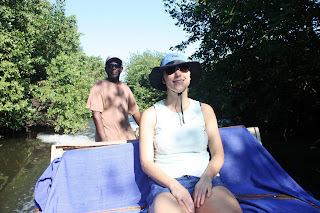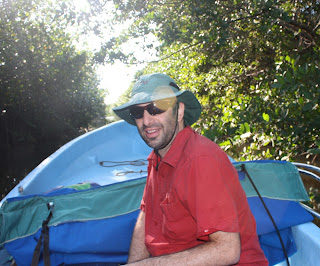I am starting to have my doubts about the entire iPad interface. To do anything on an iPad, you need to download multiple "apps", all of which require you to sign up for other services, which all need to log into each other, and all need to be able the share all kinds of data a put my personal life and whereabouts, just to copy a simple photo to a webpage. I'm starting to think an iPad is really just a clever marketing and data mining device.
Rant over, except to say I had an easier time blogging from Africa using a Palm Pilot 4. If you actually want to see the photos I have posted to go along with this blog, you might need to click on them, and who the hell knows what Dick Cheney will do with your address and birthdate if you need to "log in".
Today we decided to drive further into the Mayan mountains to the Mountain Pine Ridge.
It goes like this: at some point, if you drive far enough into the Mayan Mountains, the rocks change from limestone to granite. Given enough elevation (about 1000 metres) and granitic soils, you are no longer surrounded by rainforest jungle, but it opens up and you are surrounded by pine trees. The high plateau, rolling topography and open pine forests give the impression of being in the Cariboo or northern Okanagan. Except it is stinking hot, even on Boxing Day, even when it rains.

We bounced along a few dozen kilometers (or "miles" as they call them here) of debris-strewn lines of jagged rocks that had recently experienced intensive artillery barrages (or "roads" as they call them here), but the rental Suzuki/Chevy Crapper seemed content to take the beating. We stopped at a couple of random villages in the middle of the jungle, and saw some remarkable stone carving, both ancient and modern. We received it on good authority from and elderly Mayan stone carver and house painter that the world will not be ending in 2012... but she suggested Climate Change may get us yet. She seemed authoritative, judging by the Mayan Gods adorning her house.

We slipped down a muddy road at one point, dipping back into the limestone and the jungle, to see the Rio Frio Cave. This 40 metre high cavern passes for a few hundred metres through a limestone cliff, with gaping openings on both sides, but there is abit abit of acurve in the cave, making it vaguely Macaroni- shaped. The Rio Frio passes through, and there are beautiful stactites and other limestone features on the less accessible far wall. Tig assures me there were no spiders to be found amongst the dark crevices we scrambled past.





Back up into the Pines, we found our way to the Rio Frio Pools. Here the "Cold River" passes over some polished granite rapids, leaving a long series of pools and riffles, just large enough to swim across and deep enough to dive into. The sun steadfastly refused to shine, and there were even few sprinkles of rain, but down here at 17 degrees north of the equator, it was stil refreshing to take a dip in the pools and attempt not to be swept over shoals to... well, not really death, but likely a skinned knee or two. So we swam and knocked back the hyperthermia for a while.


I have been drinking Belikin Beer. Not because it is good, but because it is the only beer available. There is one brewery in Belize, and they produce a slightly syrupy, overly sweet and distinctly spiceless Belekin Lager. They also sell a stout, which I have not seen yet, but (having not found the lager lacking in sugar content) I can imagine it is served in wide- mouth jars to facilitate a molasses-like texture. There is third beer, Lighthouse, which is the "low calorie option", primarily because it is served in 250ml bottles. Reast assured, it is Belikin Lager that is preferred by bikini-clad ladies (according to the advertising I have seen), so Belikin Lager it is for me.
According to a semi-local we met, this is due to an effective monopoly on beer making granted the Belikin family. They also own the rights to sell Coca-Cola nationwide, and I have to admit I have not seen a Pepsi product in my week here.
Tig has been testing various combinations of fresh-squeezed fruit juice and rum. Fanta Club Soda, when available, has been a good cut. The national drink is a coconut flavored rum mixed with pineapple juice over rocks, affectionately called a "Panty Ripper". Tig had one tonight. I will report on the effects in a later post.

















































